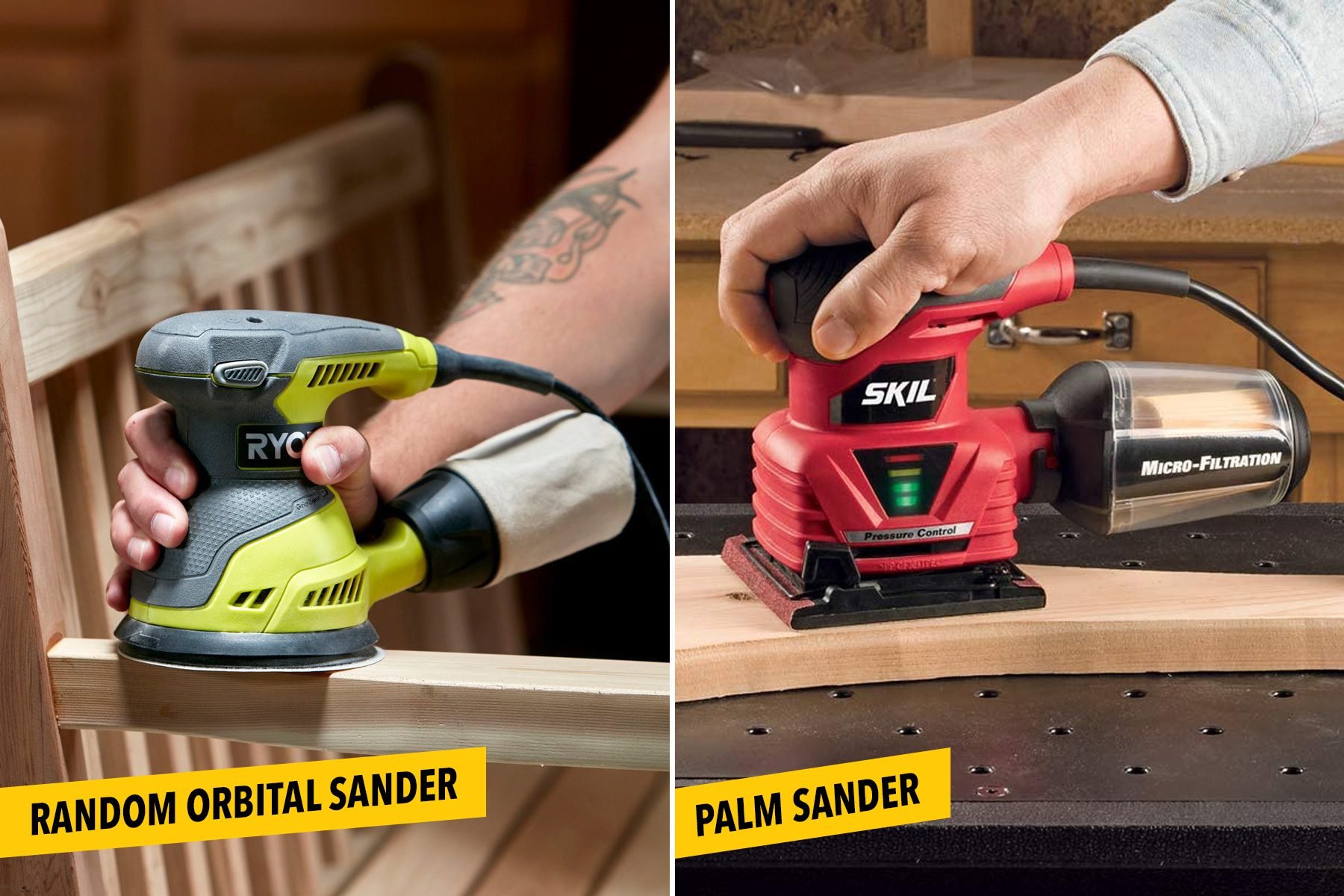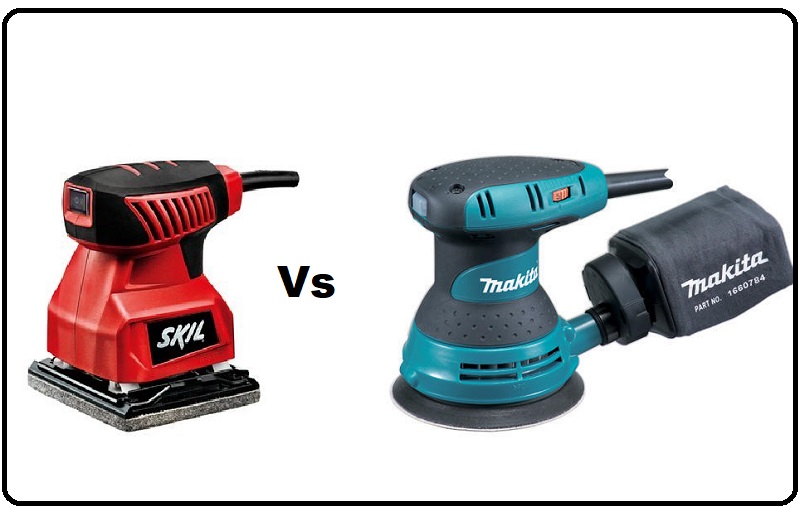When it comes to DIY projects and woodworking, having the right tools makes all the difference. But, with so many options out there, how do you choose between a palm sander and an orbital sander? Wondering which is better? Well, you’re in the right place!
In this guide, we’ll explore the key differences between palm sanders and orbital sanders, helping you make an informed decision.
So, whether you’re a seasoned DIY enthusiast or just starting out, let’s delve into the world of sanding and find out which tool is the perfect fit for your project. Let’s get started!
Are you wondering whether a palm sander or orbital sander is better? Let’s compare the features of these two power tools.
| Palm Sander | Orbital Sander |
|---|---|
| 1. Ideal for small projects and detailed work | 1. Suitable for large surface areas |
| 2. Uses a square or rectangular sanding pad | 2. Utilizes a round sanding pad |
| 3. Provides smooth and precise sanding | 3. Offers more aggressive sanding action |
| 4. Lighter and easier to maneuver | 4. Heavier but provides better control |
| 5. Less expensive than orbital sanders | 5. More expensive but versatile |
Consider your project requirements and preferences when choosing between a palm sander and orbital sander. Both have their own advantages and are suited for different applications.

Which is Better: Palm Sander or Orbital Sander?
Introduction:
When it comes to sanding, choosing the right tool for the job can make a significant difference in the quality and efficiency of your work. Two popular options for sanding are palm sanders and orbital sanders. Both of these tools have their own unique features and benefits. In this article, we will compare and contrast the strengths of palm sanders and orbital sanders, helping you make an informed decision on which one is better suited for your needs.
Benefits of Palm Sanders
Palm sanders, also known as finish sanders, are handheld power tools that are smaller and lighter than orbital sanders. They are ideal for precise sanding and finishing tasks where a smooth, even surface is desired. Here are some key benefits of palm sanders:
1. Versatility: Palm sanders are versatile tools that can be used for a wide range of projects, including sanding furniture, cabinets, and trim. They excel at removing old finishes, smoothing out imperfections, and preparing surfaces for paint or stain.
2. Easy to Maneuver: Due to their compact size and lightweight design, palm sanders are easy to maneuver around tight corners and in small spaces. This makes them particularly useful for intricate detailing work.
3. Comfortable Grip: Palm sanders are ergonomically designed with a comfortable grip, reducing fatigue during extended use. This allows you to work longer without straining your hand or wrist.
Types of Palm Sanders
There are two main types of palm sanders: sheet sanders and random orbital sanders.
1. Sheet Sanders: Sheet sanders are the most basic type of palm sander. They use standard rectangular-shaped sandpaper sheets that attach to the base of the sander with clamps or a hook-and-loop system. Sheet sanders move in a back-and-forth motion, making them ideal for flat surfaces. However, they can leave circular marks known as “swirl marks” if not used properly.
2. Random Orbital Sanders: Random orbital sanders, also known as palm-grip sanders, are more versatile and user-friendly. They have a round sanding pad that moves in both an orbital and rotational motion simultaneously. This unique movement pattern prevents swirl marks, resulting in a smoother finish. Random orbital sanders also come with a dust collection system, minimizing the mess created during sanding.
Benefits of Orbital Sanders
Orbital sanders, also known as finishing sanders, are powerful handheld tools that operate by vibrating the sanding pad in tiny circular motions. They are commonly used for sanding large, flat surfaces such as floors, tabletops, and doors. Here are some advantages of orbital sanders:
1. Fast Material Removal: Due to their high-powered motors, orbital sanders can quickly and efficiently remove material from surfaces. This makes them ideal for heavy-duty sanding tasks or when dealing with rough, uneven surfaces that require significant smoothing.
2. Smooth Finish: Orbital sanders are designed to provide a smooth, swirl-free finish. They eliminate marks and scratches left by coarser sanding grits, resulting in a polished appearance.
3. Dust Collection: Most orbital sanders come equipped with a built-in dust collection system or a dust bag attachment. This feature helps to keep your work area clean and prevents fine dust particles from entering the air, ensuring a healthier and safer working environment.
Types of Orbital Sanders
There are two main types of orbital sanders: palm-grip sanders and random orbital sanders.
1. Palm-Grip Sanders: Palm-grip sanders, as the name suggests, are held in the palm of your hand. They feature a rectangular sanding pad that moves in an orbital motion. Palm-grip sanders are effective for smaller projects and hard-to-reach areas.
2. Random Orbital Sanders: Random orbital sanders, also known as dual-action or dual-mode sanders, have a round sanding pad that moves in both an orbital and random pattern. This allows them to provide a more aggressive and efficient approach to sanding. Random orbital sanders are excellent for large-scale projects and heavy material removal.
Benefits of Palm Sanders VS Orbital Sanders
Now that we’ve discussed the individual benefits of palm sanders and orbital sanders, let’s compare them side by side:
Palm Sander Benefits:
– Ideal for precise sanding and finishing tasks
– Versatile and suitable for a wide range of projects
– Easy to maneuver in tight spaces and corners
– Provides a comfortable grip for extended use
Orbital Sander Benefits:
– Fast material removal for heavy-duty sanding
– Delivers a smooth, swirl-free finish
– Comes with a dust collection system for cleaner air and work area
– Offers options for both small-scale and large-scale projects
In conclusion, the choice between a palm sander and an orbital sander depends on your specific needs and the nature of your project. Palm sanders are excellent for detailed work and smaller areas, while orbital sanders are better suited for larger surfaces and heavier material removal. Consider the type of project you’re working on, the level of precision needed, and the amount of material you need to remove when deciding which sander is the better fit for you.
Key Takeaways: Which is Better – Palm Sander or Orbital Sander?
- A palm sander is better for smaller, detailed projects like refinishing furniture.
- An orbital sander is better for larger, flat surfaces like floors or walls.
- Palm sanders are more lightweight and easier to maneuver.
- Orbital sanders have a wider sanding area and are more efficient for larger areas.
- Ultimately, the choice between the two depends on the specific project and personal preference.
Frequently Asked Questions
Looking to find the right sander for your project? Check out these frequently asked questions to help you decide between a palm sander and an orbital sander.
1. What is the main difference between a palm sander and an orbital sander?
While both sanders are used for smoothing surfaces, the main difference lies in their sanding motion. A palm sander moves in a back-and-forth motion, while an orbital sander moves in a circular or orbital motion.
This difference in sanding motion affects the finish and the speed at which material is removed. Palm sanders excel at providing a smooth and fine finish, while orbital sanders are better suited for removing material quickly and efficiently.
2. What types of projects are best suited for a palm sander?
Palm sanders are ideal for finishing tasks that require precision and a smooth finish. They are great for working on small, intricate surfaces such as furniture, cabinets, or woodworking projects. Palm sanders are also effective at sanding corners and edges that may be harder to reach with other sanders.
If you have a project that requires delicate sanding and a professional-level finish, a palm sander is your best bet. Its back-and-forth motion ensures a controlled and even sanding result.
3. Which types of projects benefit from using an orbital sander?
If you have a large-scale project that involves sanding large flat surfaces, an orbital sander is your tool of choice. These sanders are highly efficient at removing material and are perfect for jobs such as sanding floors, decks, or walls.
Since orbital sanders move in a circular or orbital motion, they evenly distribute the sanding action and minimize the risk of leaving swirl marks on the surface. They are powerful, versatile, and can tackle various materials, making them suitable for both DIY enthusiasts and professionals.
4. Is there any overlap between the two types of sanders?
While palm sanders and orbital sanders have different primary uses, there can be some overlap in certain situations. For instance, if you need to remove a significant amount of material, you could start with an orbital sander and finish with a palm sander for a smooth and refined surface.
Ultimately, the choice between the two depends on the specific requirements of your project. Understanding their differences and common uses will help you determine the best sander for the job.
5. Are there any safety considerations when using palm sanders or orbital sanders?
Like any power tool, it’s essential to prioritize safety when using palm sanders or orbital sanders. Always wear appropriate safety gear such as safety goggles and a dust mask to protect your eyes and respiratory system from dust particles. Additionally, ensure that the sander is securely gripped and use gentle, controlled motions to avoid accidents.
It’s also crucial to read and follow the manufacturer’s instructions and guidelines when operating a sander. This will ensure you are using the tool safely and efficiently, preventing any potential injuries or damage to your work surface.

Summary
So, which is better, a palm sander or an orbital sander? Well, it depends on what you’re looking for. If you want something small and lightweight for detailed work, go for a palm sander. But if you need to cover larger areas and want a smoother finish, an orbital sander is your best bet. Consider your needs and choose accordingly!
